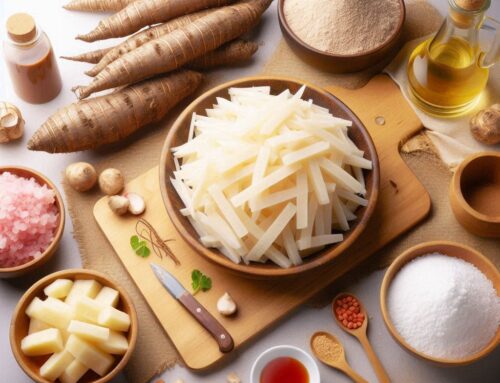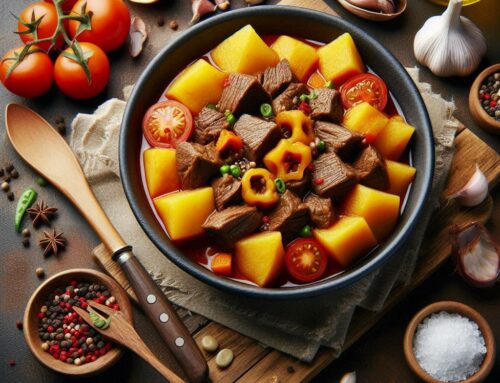
Introduction to Cassava: A Staple Root Crop with Global Significance
Cassava, a vital staple food for millions around the world, is a root crop that holds significant global importance. Known scientifically as Manihot esculenta, the cassava plant thrives in tropical and subtropical regions, making it a crucial agricultural product in countries across Africa, Asia, and Latin America. The cassava root is particularly valued for its adaptability to diverse climates and soil conditions, enabling it to grow where other crops might fail.
But what exactly is cassava? At its core, cassava is a starchy tuberous root that serves as an essential source of carbohydrates. Its versatility allows it to be processed into various forms such as flour, chips, or even tapioca pearls. This adaptability not only makes it a staple food in many diets but also positions it as an important global crop with numerous culinary and industrial applications.
Moreover, the significance of cassava extends beyond nutrition; it plays a critical role in food security and economic stability for smallholder farmers. By understanding the importance of this remarkable plant and its contribution to global agriculture, we can better appreciate its role in sustaining communities worldwide.
Culinary Uses of Cassava: From Traditional Dishes to Modern Cuisine
Cassava, a versatile root vegetable, has been a staple ingredient in many traditional dishes around the world. Its adaptability in various culinary applications makes it an exciting component of both time-honored recipes and modern cuisine innovations. Understanding how to cook cassava is essential for unlocking its full potential.
One of the most common uses of cassava is in tapioca production. The starch extracted from cassava roots is transformed into tapioca pearls, which are widely used in desserts and beverages like bubble tea. This process highlights the unique textural properties of cassava starch, which can add a delightful chewiness to sweet treats.
In addition to tapioca, cassava flour has become increasingly popular in baking due to its gluten-free nature. Cassava flour can be used as a substitute for wheat flour in many recipes, providing an alternative for those with gluten sensitivities or dietary restrictions. It works well in breads, pastries, and even pizza crusts, offering a slightly nutty flavor that complements both savory and sweet dishes.
Traditional cassava recipes often feature this root vegetable boiled or fried as a side dish or incorporated into stews and soups. In some cultures, it is fermented to create flavorful staples like fufu or gari. These methods not only enhance the taste but also improve the nutritional profile by making nutrients more bioavailable.
As chefs continue to experiment with this adaptable ingredient, new culinary uses of cassava are emerging that blend traditional techniques with contemporary flair. Whether you’re exploring classic preparations or venturing into innovative creations, incorporating it into your cooking repertoire offers endless possibilities for delicious meals.
Nutritional Profile of Cassava: Health Benefits and Considerations
Cassava, a staple in many tropical regions, is a versatile root vegetable that offers several nutritional benefits. Understanding the nutritional value of cassava can help you make informed dietary choices. It is primarily composed of carbohydrates, making it an excellent energy source. A 100-gram serving of boiled cassava root contains approximately 112 calories, largely from its carbohydrate content.
In addition to being calorie-dense, it provides essential nutrients such as vitamin C, which supports immune function and skin health. It also contains small amounts of other vitamins and minerals like thiamine (vitamin B1), riboflavin (vitamin B2), and niacin (vitamin B3), all of which play crucial roles in energy metabolism.
The health benefits of cassava extend beyond its nutrient content. It is naturally gluten-free, making it a suitable alternative for those with celiac disease or gluten sensitivity. Furthermore, when prepared correctly to remove naturally occurring toxins like cyanogenic glycosides, itcan be part of a balanced diet that supports overall health.
However, it’s important to consider some precautions when consuming cassava. Due to its high carbohydrate content and glycemic index, individuals monitoring their blood sugar levels should consume it in moderation. Additionally, proper preparation methods are essential to ensure the removal of toxins that can pose health risks if consumed in large quantities.
In summary, while the nutritional profile of cassava offers several health benefits due to its energy-providing carbohydrates and essential vitamins and minerals, consumers should be mindful of preparation techniques and portion sizes to maximize its benefits safely.
Cassava Versus Other Carbohydrate Sources: How Does it Compare?
Cassava, a staple in many tropical regions, is often compared to other carbohydrate sources like potatoes, rice, and corn. When it comes to cassava vs potatoes, both serve as excellent sources of energy due to their high carbohydrate content. However, it stands out as a gluten-free alternative that is particularly beneficial for those with gluten sensitivities or celiac disease. Unlike potatoes, which contain some protein and fiber, it is primarily composed of carbohydrates and requires careful preparation to remove naturally occurring toxins.
In comparison with rice and corn, it offers a distinct nutritional profile. Rice is a versatile grain that can be easily integrated into various diets but lacks the fibrous texture found in corn. Corn provides dietary fiber along with essential vitamins such as B-complex vitamins and vitamin C. Cassava’s advantage lies in its ability to thrive in poor soil conditions where other crops might fail, making it an essential food security crop in many parts of the world.
Overall, when considering carbohydrate sources comparison for dietary needs or culinary uses, it’s important to weigh each option’s nutritional benefits and suitability for specific dietary restrictions. It presents itself as a viable choice among gluten-free alternatives while providing ample energy through its rich carbohydrate content.
The Role of Cassava in Gluten-Free and Alternative Diets
Cassava, a versatile root vegetable, has gained significant attention in recent years for its role in gluten-free and alternative diets. As more individuals seek to manage dietary restrictions or explore healthier eating habits, it stands out as a valuable ingredient due to its naturally gluten-free properties. Unlike wheat and other grains that contain gluten, cassava offers a safe and nutritious option for those with celiac disease or gluten sensitivities.
Beyond its gluten-free benefits, it is rich in carbohydrates and provides a substantial energy source while being low in fat. This makes it an excellent choice for people following alternative diets that focus on high-energy foods without the inclusion of traditional grains. Cassava flour is particularly popular among bakers looking to create bread, cakes, and pastries that cater to these dietary needs without sacrificing taste or texture.
Moreover, cassava’s adaptability extends beyond baking. It can be used to make tapioca pearls for puddings or bubble tea and serves as a thickening agent in soups and sauces. Its mild flavor allows it to blend seamlessly into various recipes, making it an ideal staple in any kitchen focused on diverse dietary requirements.
Incorporating it into your diet not only supports those with specific health needs but also adds variety and nutritional value to everyday meals. As awareness grows about the importance of accommodating different dietary preferences, the role of cassava continues to expand within the culinary world.
The Role of Cassava in Food Security and Economic Development
It plays a pivotal role in enhancing food security and driving economic development, particularly in developing countries. As a robust food security crop, cassava is highly valued for its ability to thrive in diverse climatic conditions and poor soils where other crops might fail. This resilience makes it an essential staple for millions of people, providing a reliable source of carbohydrates and vital nutrients.
Economically, cassava farming offers significant benefits to rural communities. It serves as a critical cash crop that supports the livelihoods of smallholder farmers by providing them with income opportunities through local and international markets. The economic importance of cassava extends beyond direct sales; it also stimulates related industries such as processing, transportation, and retail.
In many developing countries, the cultivation of cassava helps mitigate the effects of economic volatility by offering a stable income stream. Governments and NGOs often emphasize supporting the farming community with resources and expertise to maximize yields and improve market access. By focusing on enhancing both production techniques and market infrastructure, these efforts help solidify cassava’s role as a cornerstone of food security strategies while fostering sustainable economic growth within these regions.
Pitfalls and Precautions When Using Cassiva: What You Need to Know
Cassava, a staple in many parts of the world, is a versatile root vegetable known for its nutritional benefits. However, consuming cassava requires careful attention due to potential health risks associated with its natural cyanide content. Understanding these pitfalls and taking necessary precautions can ensure safe consumption.
One of the primary safety precautions for eating raw cassava is recognizing that it contains cyanogenic glycosides, which can release cyanide when improperly prepared. This makes it crucial to never consume cassava raw. Risk factors increase significantly if proper preparation methods are not followed, potentially leading to cyanide poisoning.
Safe preparation methods are essential for reducing these risks. Always peel the cassava thoroughly and cook it well—boiling, baking, or frying are effective ways to break down harmful compounds. Additionally, soaking peeled cassava in water for several hours before cooking can further reduce cyanide levels.
By adhering to these guidelines and respecting the necessary precautions when handling and preparing cassava, you can enjoy this nutritious root safely as part of your diet without worry.






